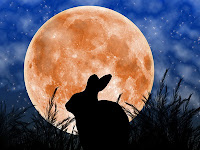Yet in other traditions, Hare was a Trickster figure,wiley,quick and mystical. He is credited with the creation of the Midewiwin, or Grand Medicine Society of the Northeastern native tribes, a secret magical lodge. Their gathering places are in open spaces beneath the moon, or in domed structures which mimic the shape of the moon [ https://en.wikipedia.org/wiki/Midewiwin].
The hare is associated by most tribal peoples with birth and rebirth (partly due to its relatively short gestational period of 30 days), an auspicious creature sacred to their culture because of its fertility and abundance.
However, not every ancient culture thought so highly of them: the Biblical book of Leviticus called the hare or rabbit "unclean". Others thought the creature so taboo that it was unlucky to even speak its name. The Greeks of antiquity protected the hare " ...for the sake of Artemis" because it was one of her symbols and therefore refused to hunt it. Superstitions were frequently associated with the hare or rabbit because they were believed to be a common disguise for witches and commonly witches' familiars ( a close second to the black cat). It was purported that the only way to kill a witch who had shape shifted into a hare or rabbit was with a bullet made of silver-the moon's metal. ( Much like the werewolf myth.)
The hare was lucky or unlucky at various times in history, as folk lore associated with them morphed and changed in public opinion. During World War I, it became the fashion for loved ones to give a soldier going off to war "a lucky rabbit's foot" ( But not so lucky for the rabbit, eh?) Mothers hung the amulet above their children's beds for protection throughout the night. With this new positive association came the habit of saying " White Rabbits, White Rabbits, a pinch and a punch for the first of the month" ( or variations such as " Rabbit, Rabbit") to wish others good fortune throughout the month.


